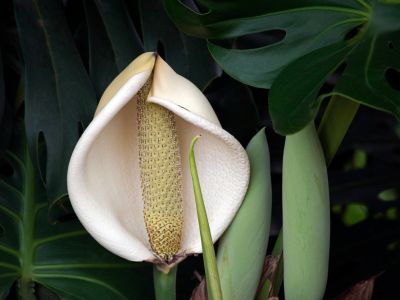Monstera Deliciosa Flower
Monstera belongs to the same plant group as skunk cabbage and Jack-in-the-pulpit, and the resulting monstera plant flower looks much the same. The Monstera “flower” is a fleshy erect spadix or spike with tiny blooms surrounded by a boat-shaped spathe. Monstera deliciosa flowers are creamy white and large, about 8-12 inches (20-38.4 cm.) in length.
Monstera Deliciosa Fruit
A Monstera may bloom and fruit at the same time due to the lengthy period of time the plant takes to bring an inflorescence to a mature fruit. This means there will be ripening fruit, immature fruit and unopened inflorescences appearing concurrently on the same plant. Monstera fruit takes 12-14 months to ripen. Monstera fruit is called a spadix and is comprised of numerous berries that are initially covered by a waxy bract (spathe) that drops from the fruit as it matures. The green, cone-like fruit is 8-14 inches (20-36 cm.) long by 2-3.5 inches (5-9 cm.) across. The outer peel is composed of hexagonal shaped scales that cover the sections of off white, juicy pulp. Among the fruit segments are small black remnants of flowers and very rarely any seeds. The fruit of Monstera deliciosa, as with the entirety of the plant, contains oxalic acid. However, it is rendered harmless once the fruit has matured.
How to Make Monstera Bloom
Native to wet forests of southern Mexico, Guatemala and portions of Costa Rica and Panama, Monstera cannot handle cold temps. Creating the exact conditions to mimic these regions in order to get Monstera to bloom would likely require a climate controlled greenhouse. In the wild, Monstera thrives in semi-shade in well-drained, rich, moist loam. In the home, Monstera should be grown in bright light in the summer and direct sun in the winter, with warm room temperatures and medium to high humidity. The soil should be nutrient rich and the container should be large enough to provide ample growth space. A support such as a moss covered slat should be used to keep the stems from breaking. Water deeply and then allow the soil to dry slightly between waterings. Make sure to water the moss covered support as well.
